
|   |

|   |
 e-mail: leelakaverivenkat@gmail.com Shriram Bharatiya Kala Kendra's three day Ballet Festival Photos courtesy: SBKK May 25, 2024 The Indian Ballet as an art form, operating in a climate of artistic freedom, with style and technique, classical or otherwise, dictated by the need to experiment and expand the movement vocabulary in order to communicate to a cosmopolitan audience, has found its most fertile field of operation in Delhi's Shriram Bharatiya Kala Kendra. Aside from its magnum opus Ramayan and Krishna creations, the institution has to its credit over 60 dance drama productions, set mainly in movements of Kathak, Chhau, and Folk - their attraction and ability for luring large audiences, not lessening a whit over the years. This year's Ballet festival projected over three days comprised three productions, Parikrama, Karna and Meera, each as different from the others as chalk from cheese. If Parikrama dealt with an abstract theme, Karna brought out the tragic story of a Mahabharata hero who despite being invested with all the noble qualities, was destined to a life of unmitigated misfortune. His unjust end came while fighting, ironically, for Dharma. Meera on the other hand, was the tale of the saint poetess, who, born in a patriarchal society and chained to the stifling orthodoxy surrounding royalty, courageously fights her way to emancipation. And given the fact that the same cast had to present three very different productions immaculately, with not a cue missed, on three consecutive evenings, one can imagine the scale of rehearsals and attention to detail in the preparation! 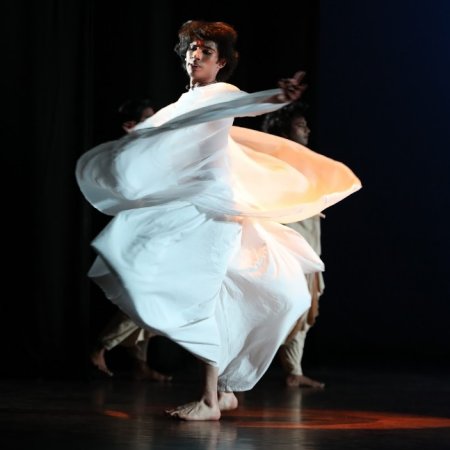 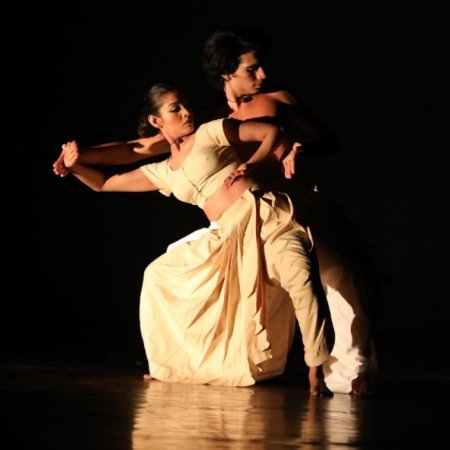 The opening day's ballet Parikrama, spun round ideas woven with the Indian psyche, more like states of the mind, had a theme, defying being fleshed out through dance movement - ideas like Being and Non Being - terms dealing with the inner human being, and philosophized on. How does one visualise the soul or Atman achieving moksha, liberating itself from the five senses of sight, sound, touch, smell and taste? What is the gestural language for Being and Non Being or mind and intellect? This theme, after years of creating painless enjoyment for the audience, dealing with objectified legendary heroes like Rama or Krishna, must have posed a challenge. And to the credit of director Shobha Deepak Singh and the dance choreographer Shashidaran, (who was deputed as Mayurbhanj Chhau teacher to the Kendra sometime in 1976) using Chhau came as a brilliant idea - for without any hand gestures or mudras, the dancer balanced on one leg anchored to the floor, while the other moves in the air tracing patterns, enables suggesting ideas, with no definite object being visualized. This abstraction is just what was needed to suggest ideas like Atman, mind and what have you. This Chhau rhythm-in-the-air, with Sant Kabir's mystic poetry for script, strung to music and sung by Shubha Mudgal, provided the base for some imaginative movement imagery explored in Shashidharan Nair's choreography. The very unusual narrative is set off with Hiranyagarbh, the golden egg covered with the five elements ether, wind, fire, water, earth where 'nothing is and everything was'. In a state of non-being, Brahman the soul of the Hiranyagarbha, in the desire to manifest to a state-of-being as Atman, enters a human body on earth. The soul in the energized body with its five senses is fine till caught in the web of the senses, through seemingly endless rebirths and deaths, the Atman finally seeks liberation from the body. The group with Justin McCarthy and Jayamala Aiyer (who advised Shobha Deepak Singh to read the Padma Purana to familiarize herself with the subject) as advisors, along with singer Shubha Mudgal, and of course Shobha Deepak Singh and Shashidharan, formed the core group who through constant interactions arrived at ideas on communicating this abstract theme.  Parikrama While B.K.K's group discipline in dance has always been its strongest factor, with constant practice, almost turning dancers into automatons who cannot go wrong, the choice of Shivam Sahni, who has never had any formal dance training, as the hero Atman, spoke of great courage along with a shrewd understanding of what the role entailed. And one has to comment on the sangfroid of the dancer, who never betrayed a sense of nerves at having to play a lead role in a dance event. Not having been through the step by step formal training in Chhau, Shivam lacks the minute torso genuflexions of the regular dancers of this style. But his naturally graceful body makes up with phenomenal balance, displayed in the rock steady stances - with not just one leg grounded - but more importantly, with the dancer balanced on head with both legs in the air. Not once did he falter. Atman, trying to find its place amidst the indriyas, the pancha tatwas, the large Hiranyagarbh within which lay Atman slowly emerging into clarity, and the subsequent Parikrama interactions with the senses, both amiable and less so, apart from dance movement had the sensitive light effects of Gautam Bhattacharya - a state which Shobha Deepak Singh in the pamphlet very poetically defines as …you could see music and hear dance. ABSTRACTION TO DRAMA OF THEATRE  Karna Karna as powerful theatre, not surprisingly, had many in the audience on the verge of tears. How many Karnas of sterling character in this world have been damned to unmitigated misfortune from birth to death? Produced and directed by Shobha Deepak Singh, the dance visualization by Shashidharan Nair assisted by Raj Kumar Sharma, conceptualized on script and dialogue based on Late Ram Dhari Kinkar's powerful poetry in Rashmi Rathi, with the dialogues spoken in the deep and unforgettable voices of late Manohar Singh, Jayati Bhatia and Sushant Singh, with Varun Gupta's music and with Manju Kohli and Monika's designing of costumes, ornaments and sets, Karna, for this critic, was the pick of the three productions. 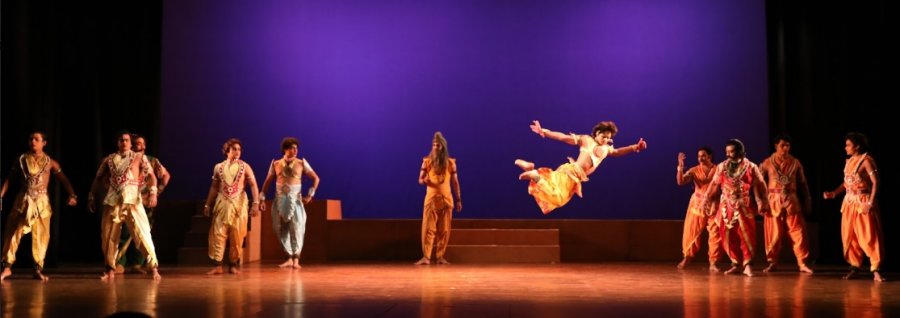 Karna Moving at a swift pace, with no moment needlessly spun out, playing out, is the stark irony of adharma in the midst of a war fought for righteousness! One wonders if Draupadi being shared by five husbands, and her horrendous disrobing, thanks to a husband gambling away his wife in a game of dice, could be described as righteous acts? Was it dharma denying Karna every opportunity of participating in any feats of strength and proficiency, merely on the basis of caste? To escape societal censure, was Kunti's act of making her first male child (born out of pre-marital relations, albeit through an impetuous action prompted by the untried innocence of youth) float away in a basket in the river waters, righteous? Even Lord Indra commits the unholy act of appearing before Karna in the guise of a Brahman and through devious means, depriving this son of Surya of the Kavach / kundal protection he was born with. Perhaps the height of ingloriousness lay in mother Kunti's act of stealing into the Kaurava camp at dead of night, to emotionally blackmail Karna (who had never been given the right to know or acknowledge her as Mother) pleading that he cross over to the Pandava side and lead them in battle and not kill his own brothers! Caught between the agonized pleadings of a mother who till this moment had watched his travails as Suta Putra, despite his royal birth, and his loyalty to the only well-wisher Duryodhana, who amidst the sea of rebuffs, had befriended him, making him the ruler of Anga, and appointing him as commander-in-chief of the Kaurava army, Karna, ever magnanimous, promised not to enter into battle combat against any of the Pandavas, barring Arjuna. "And if one of us perishes, you will still be mother of Pancha Pandavas!" he tells Kunti. And how lowly was the act of killing Karna when he was struggling with a chariot wheel stuck in the ground of the battle field!  Karna In a theme where over emoting was always a danger, the restraint in every action showed great discipline. Tullu Murmu as Karna, took to the role with praiseworthy involvement. Very moving, he emotionally seemed to become one with the role. Raj Kumar Sharma with his height and presence looked his part as Surya and also as Krishna. Also convincing in short roles were Swapan Majumdar as the rough Duryodhana and choreographer Shashidharan Nair himself in the role of Parashuram, who, sleeping on Karna's lap, suddenly wakes up cursing him for deceiving him about being a fellow Brahmin - when he was indeed a Kshatriya. The two main female dancers Moulina Singh and Rituparna Das as Kunti and Draupadi, acquitted themselves creditably. And one welcomed the very suggestive capturing of Draupadi's disrobing! MEERA'S FIGHT FOR LIBERATION AMIDST FEUDAL SUPPRESSION 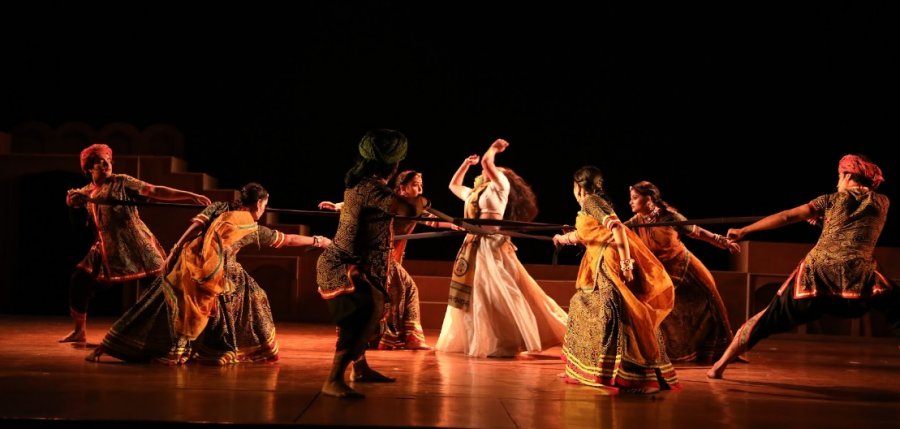 Meera Imprisoned in the golden cage of feudal orthodoxy in a patriarchal society, Meera, for all times, has become a symbol of woman's emancipation and fight for liberation. Bharatiya Kala Kendra's penchant for Kathak and Mayurbhaj Chhau apart with Shashidharan Nair and Rajkumar's choreography, Meera through vivid snippets of folk forms like Ghoomar, Kachhi Ghodi and what have you, captures the typical Rajasthani ambience. With two art stalwarts from Rajasthan, Komal Kothari as Production Advisor also providing script inputs and Keshav Kothari designing the sets, it could not but be so. Along with the powerful throb of Shubha Mudgal's music rendered in the voices of Radhika Chopra and Shubha herself, with Manish Khullar and Hameed Khan chipping in as male voices, songs like Dheere jhalari, Supuname prane Gopal, Mare to Guru Govindji, Ranaji mere to Giridhar preeto pyare ring in the ears. And with Shobha Deepak Singh's overall direction and exquisitely designed costumes, action takes place at different levels on stage and also on the floor space in front of the audience - showing processions passing. 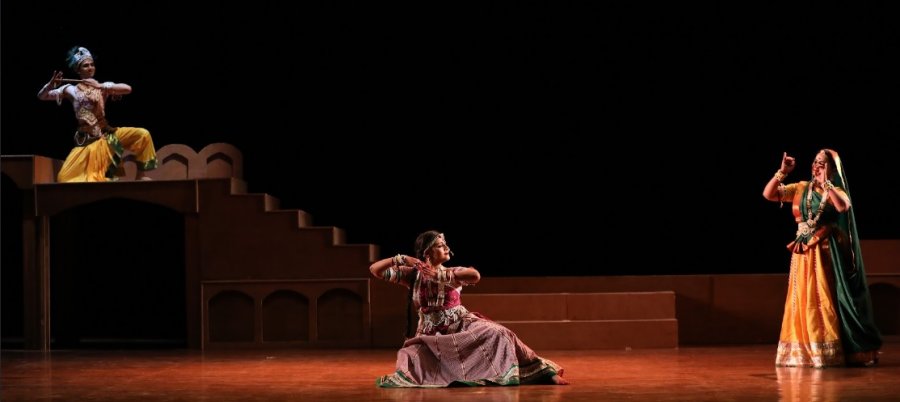 Meera Meera symbolizes, aside from its Rajasthani environs, woman's fight for an equal say in life activities, in what has always been, a male dominated society. With two Meera-s in Molina Singh and Rituparna Das, the ballet succeeds in communicating how, right from childhood, Meera's preoccupation with Krishna, and her attraction for following Krishna bhakt minstrels - in advancing years crystalized into a steadily growing determination to cut off all connections with society (last remnants of obligation, if any, to the societal order she was born to, washed away by the cold blooded attempts to do away with her). And she leaves the palace to pursue her desire, with the dare 'Ranaji, ab na rahoongi tori, hatke' Molina's grace and refined feel for mood with fluid facial expressions, reflect all the inner turmoil subsiding for one never attracted by material possessions, with the raging desire to become one with the Lord. 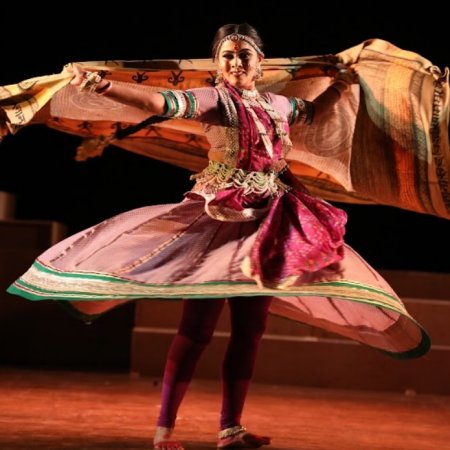 Meera In smaller roles, the male cast of Raj Kumar Sharma as Sadhu, Swapan Majumdar and Kanishk as Rana and Shivam Sahni in the usual role as Krishna, acquits itself well too. With the delightful photographs arranged in the lobby, and handsome audience turnout, the three day event was a great success.  Writing on the dance scene for the last forty years, Leela Venkataraman's incisive comments on performances of all dance forms, participation in dance discussions both in India and abroad, and as a regular contributor to Hindu Friday Review, journals like Sruti and Nartanam, makes her voice respected for its balanced critiquing. She is the author of several books like Indian Classical dance: Tradition in Transition, Classical Dance in India and Indian Classical dance: The Renaissance and Beyond. Post your comments Pl provide your name and email id along with your comment. All appropriate comments posted with name and email id in the blog will also be featured in the site. |